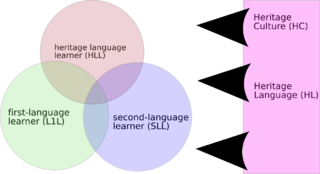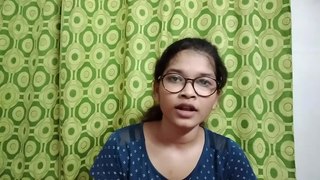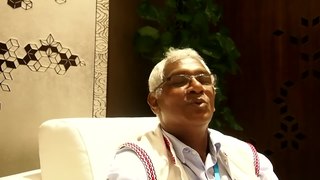Related Research Articles

An endangered language or moribund language is a language that is at risk of disappearing as its speakers die out or shift to speaking other languages. Language loss occurs when the language has no more native speakers and becomes a "dead language". If no one can speak the language at all, it becomes an "extinct language". A dead language may still be studied through recordings or writings, but it is still dead or extinct unless there are fluent speakers. Although languages have always become extinct throughout human history, they are currently dying at an accelerated rate because of globalization, imperialism, neocolonialism and linguicide.

Languages spoken in India belong to several language families, the major ones being the Indo-Aryan languages spoken by 78.05% of Indians and the Dravidian languages spoken by 19.64% of Indians, both families together sometimes known as Indic languages. Languages spoken by the remaining 2.31% of the population belong to the Austroasiatic, Sino–Tibetan, Tai–Kadai and a few other minor language families and isolates. India has the world's fourth highest number of languages (447), after Nigeria (524), Indonesia (710) and Papua New Guinea (840). The Indian subcontinent is home to the third most spoken language in the world, Hindi-Urdu; the sixth most spoken language, Bengali; and the twelfth most spoken language, Punjabi.

The Munda languages are a language family spoken by about nine million people in India and Bangladesh. Historically, they have been called the Kolarian languages. They constitute a branch of the Austroasiatic language family, which means they are related to languages such as Mon and Khmer languages and Vietnamese, as well as minority languages in Thailand and Laos and the minority Mangic languages of South China. Ho, Mundari, and Santali are notable languages of this group.

Santali, also known as Santali, is the most widely spoken language of the Munda subfamily of the Austroasiatic languages, related to Ho and Mundari, spoken mainly in the Indian states of Assam, Bihar, Jharkhand, Mizoram, Odisha, Tripura and West Bengal. It is a recognised regional language of India per the Eighth Schedule of the Indian Constitution. It is spoken by around 7.6 million people in India, Bangladesh, Bhutan and Nepal, making it the third most-spoken Austroasiatic language after Vietnamese and Khmer.
Ho is a Munda language of the Austroasiatic language family spoken primarily in India by about 1.04 million people per the 2001 census. Ho is a tribal language. It is spoken by the Ho, Munda, Kolha and Kol tribal communities of Odisha, Jharkhand, Bihar, Chhattisgarh, West Bengal, Assam and is written with the Warang Citi script. Devanagari, Latin script, Odia script and Telugu script are sometimes used, although native speakers are said to prefer a Ho script. The latter script was invented by Ott Guru Kol Lako Bodra.

The Tat language, also known as Tat/Tati Persian, is a Southwestern Iranian language closely related to, but not fully mutually intelligible with Persian and spoken by the Tats in Azerbaijan and Russia. There is also an Iranian language called Judeo-Tat spoken by Jews of Caucasus.
The Gutob or Bodo Gadaba language is a south Munda language of the Austroasiatic language family of India, with the greatest concentrations of speakers being found in Koraput district of Odisha and Visakhapatnam district of Andhra Pradesh. It is also known simply as the Gadaba language, but it is different from the Dravidian Gadaba language. Other names for the Bodo Gadaba language include Gadba, Gutop, Gudwa, Godwa, Gadwa, and Boi Gadaba.

The Kharia language is a Munda language of the Austroasiatic language family, that is primarily spoken by the Kharia people of eastern India.

Sora is a south Munda language of the Austroasiatic language of the Sora people, an ethnic group of eastern India, mainly in the states of Odisha and Andhra Pradesh. Sora contains very little formal literature but has an abundance of folk tales and traditions. Most of the knowledge passed down from generation to generation is transmitted orally. Like many languages in eastern India, Sora is listed as 'vulnerable to extinction' by UNESCO. Sora speakers are concentrated in Odisha and Andhra Pradesh.

Korku or is an Austroasiatic language spoken by the Korku tribe of central India, in the states of Madhya Pradesh and Maharashtra. It is isolated in the midst of the Gondi people, who are Dravidian, while its closest relatives are in eastern India. It is the westernmost Austroasiatic language.
The Juang language is an Munda language of the Austroasiatic language family spoken primarily by the Juang people of Odisha state, eastern India.
The Gtaʼ language is an Austroasiatic language spoken by the Didayi people of India. It is notable for its sesquisyllabic phonology and vigesimal numeral system.

Mundari (Munɖari) is a Munda language of the Austroasiatic language family spoken by the Munda tribes in eastern Indian states of Jharkhand, Odisha and West Bengal. It is closely related to Santali. Mundari Bani, a script specifically to write Mundari, was invented by Rohidas Singh Nag. It has also been written in the Devanagari, Odia, Bengali, and Latin writing systems.

Nihali, also known as Nahali or erroneously as Kalto, is a moribund language isolate that is spoken in west-central India, with approximately 2,000 people in 1991 out of an ethnic population of 5,000. The Nihali tribal area is just south of the Tapti River, around the village of Tembi in Nimar district (Burhanpur) of Madhya Pradesh. Speakers of the Nihali language are also present in several villages of the Buldhana district in Maharashtra such as Jamod, Sonbardi, Kuvardev, Chalthana, Ambavara, Wasali, and Cicari. There are dialectal differences between the Kuvardev-Chalthana and the Jamod-Sonbardi varieties.
Koro is a possibly Sino-Tibetan language spoken by approximately 800–1,500 people in the East Kameng district at the western end of Arunachal Pradesh, India. Few speakers are under 20 years old. The people live among the Aka (Hruso), but their language is only distantly related, with distinct words for numerals, body parts, and other basic vocabulary. The majority of Koro speakers live in bilingual households in which one or more members speak Ako or another indigenous language rather than Koro. Although it has resemblances to Tani farther to the east, it appears to be at least a separate branch of Sino-Tibetan. Researchers hypothesize it may have originated from a group of people enslaved and brought to the area.
Juray is a Munda language of India, spoken in Gajapati district in southern Odisha. It is very close to Sora: Gregory Anderson (2008:299) considers Juray to be a Sora dialect. It is currently severely endangered.
Lodhi is a Munda language, or dialect cluster, of India. Kharia Thar is only spoken by one quarter of ethnic Lodhi in Orissa. However, while admitting that Lodhi is related to Sora, a Munda language, Ethnologue classifies it as Indic (Bengali–Assamese), and it is considered a variety of Hindi in the Indian census. It may be that there are both Munda and Indic varieties subsumed under the name Lodhi.
The Birjia language, also known as Binjhia or Bijori, is a language of India. It is commonly assumed to be a Munda language closely related to the Asuri language. However, Anderson, based on Prasad (1961:314), suggests that Birjia (Binjhia) may be an Indo-Aryan language, although the Birjia are a tribe of the Asuri nation. The latter include the Asur and the Agariya.
Korwa, or Kodaku/Koraku (Korku), is a Munda language of India spoken in Chhattisgarh and Jharkhand.

The Munda peoples of eastern and central parts of South Asia are any of several tribal groups of people who natively speak Munda languages, formerly also known as Kolarian.
References
- ↑ Parenga at Ethnologue (19th ed., 2016)
- ↑ "UNESCO Atlas of the World's Languages in danger". www.unesco.org. Retrieved 2018-08-15.
- ↑ http://www.endangeredlanguages.com/lang/4953 Endangered Language Project
- ↑ Sitapati, G.V. 1933. “Pareng.” A Miscellany of Papers Presented to Rao Sahib Mahopadhyaya Gidugu Venkata Ramamurthi. Madras. 145-65
- ↑ Anderson, Gregory D.S. & Felix Rau. 2008. “Gorum.” In: Gregory D.S. Anderson
- Anderson, Gregory D.S (ed). 2008. The Munda languages. Routledge Language Family Series 3.New York: Routledge. ISBN 0-415-32890-X.